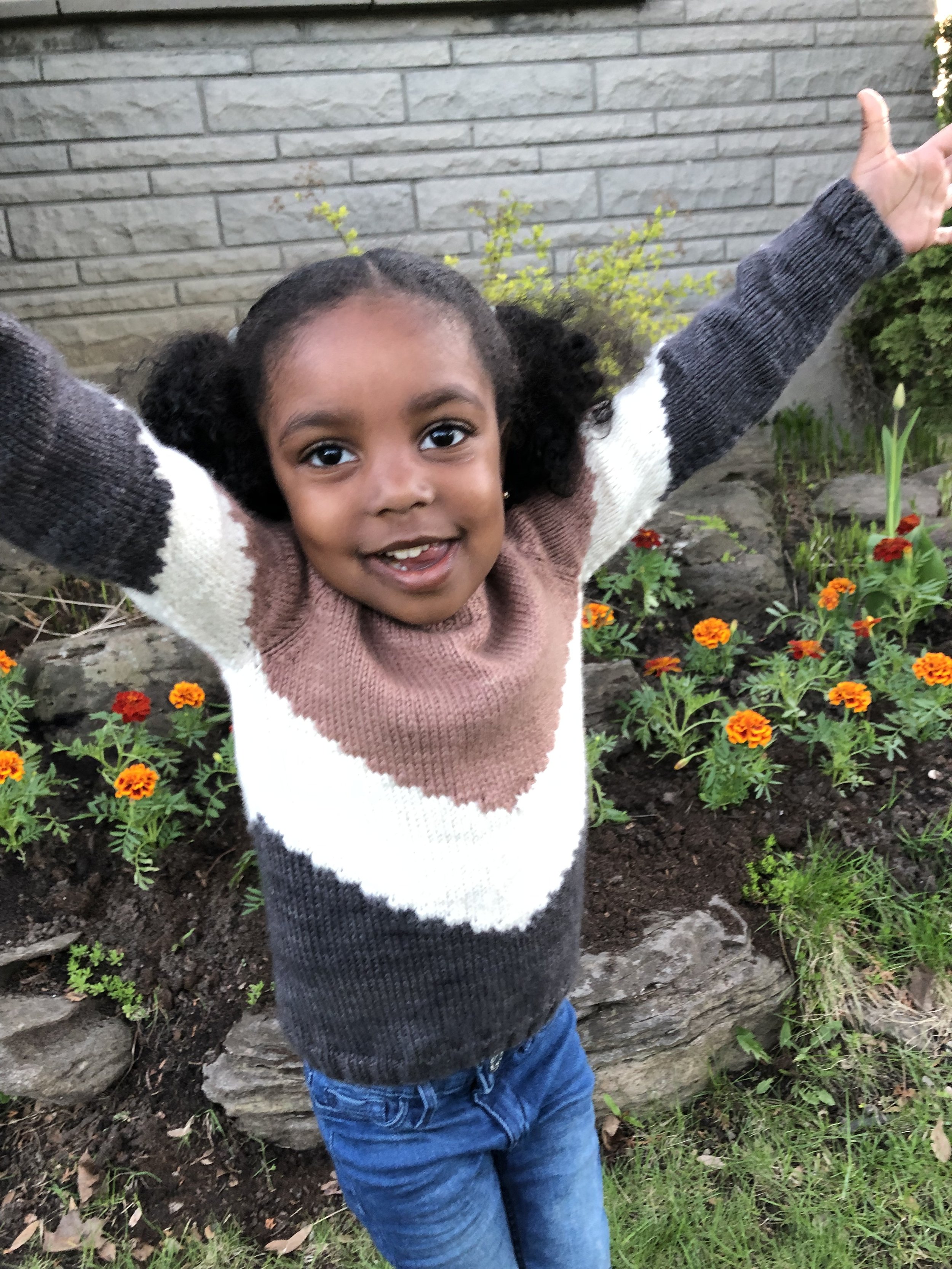Avery
My first gender neutral pattern.
This knit was created for my babies.
A sweater that can passed from my daughter to my son effortlessly.
This sweater is worked from the bottom up seamlessly. First, you knit the body and the two sleeves separately.
Then, join the work in the round to complete the yoke.
The colourwork is worked with intarsia back and forth across the body and the sleeves.
Intarsia is a knitting colourwork technique that involves knitting with blocks of colour.
Each colour of yarn is its own unit, with the strands being twisted together when you change colours to connect the pieces.
Recommended ease: 2 - 3“ (5 - 8 cm) of positive ease.
Model shown is wearing a size 3 with chest measuring 20”, age: 3 1/2 yrs.
My first gender neutral pattern.
This knit was created for my babies.
A sweater that can passed from my daughter to my son effortlessly.
This sweater is worked from the bottom up seamlessly. First, you knit the body and the two sleeves separately.
Then, join the work in the round to complete the yoke.
The colourwork is worked with intarsia back and forth across the body and the sleeves.
Intarsia is a knitting colourwork technique that involves knitting with blocks of colour.
Each colour of yarn is its own unit, with the strands being twisted together when you change colours to connect the pieces.
Recommended ease: 2 - 3“ (5 - 8 cm) of positive ease.
Model shown is wearing a size 3 with chest measuring 20”, age: 3 1/2 yrs.
My first gender neutral pattern.
This knit was created for my babies.
A sweater that can passed from my daughter to my son effortlessly.
This sweater is worked from the bottom up seamlessly. First, you knit the body and the two sleeves separately.
Then, join the work in the round to complete the yoke.
The colourwork is worked with intarsia back and forth across the body and the sleeves.
Intarsia is a knitting colourwork technique that involves knitting with blocks of colour.
Each colour of yarn is its own unit, with the strands being twisted together when you change colours to connect the pieces.
Recommended ease: 2 - 3“ (5 - 8 cm) of positive ease.
Model shown is wearing a size 3 with chest measuring 20”, age: 3 1/2 yrs.
SIZES
1 (2, 3, 4, 5) (6, 7, 8, 9)
FINISHED CHEST CIRCUMFERENCE
20, 22, 23, 24, 25 (26, 28, 30, 32) inches
50, 56, 58, 61, 64 (66, 71, 76, 81) cm
APPROX. AGE EQUIVALENCE
6-12 mo (1-2 yrs, 2-3 yrs, 3-4 yrs, 4-5 yrs) (5-6 yrs, 7-8 yrs, 9-10 yrs, 10-12yrs)
YARN
Weight: DK
MC: 1 (1, 2, 2, 2) (2, 2, 2, 3) skeins
210 (230, 260, 275, 290) (315, 375, 420, 530) yd
190 (210, 235, 250, 260) (285, 340, 380, 470) m
CC1: 1 (1, 1, 1, 1) (1, 1, 1, 1) skein
80 (90, 100, 105, 115) (125, 145, 160, 205) yd
75 (80, 80, 95, 105) (115, 130, 145, 185) m
CC2: 1, 1, 1, 1 (1, 1, 1, 2) skein
115 (125, 140, 150, 160) (170, 200, 230, 285) yd
105 (115, 125, 135, 145) (155, 180, 210, 255) m
Each skein should have at least 246 yd (223 m).
Yarn breakdown per section
400 (440, 500, 525, 560) (610, 720, 810, 1020) yds
360 (400, 450, 475, 505) (550, 650, 730, 920) m
MC: 52% ┃ CC1: 20% ┃ CC2: 28%
Sample shown in
AnniePaaren Davies - DK non-superwash - 246 yd (223 m)
MC (Vinyl), CC1 (Chalk), CC2 (Courtyard)
NEEDLES
Circular needles, at least 16 or 24 inches (40 or 60 cm) long, in two sizes:
3.75mm (US #5) needles for ribbing
4mm (US #6) needles for body and arms
Sets of DPN needles in the same two sizes for the sleeves, if you’re not using the magic-loop method
GAUGE
22 sts X 30 Rows = 4 rows in Stockinette on 4mm needles (or size needed to get gauge)
TOOLS
Stitch markers (one to distinguish BOR, and a removable marker or progress keeper)
Scissors
Tapestry needle
Waste yarn or stitch holders
TECHNIQUES USED
The colour work is worked with the intarsia back and forth.
The “V” pattern is on the front, back and the sleeves.
Challenge yourself by maybe learning a new technique!



